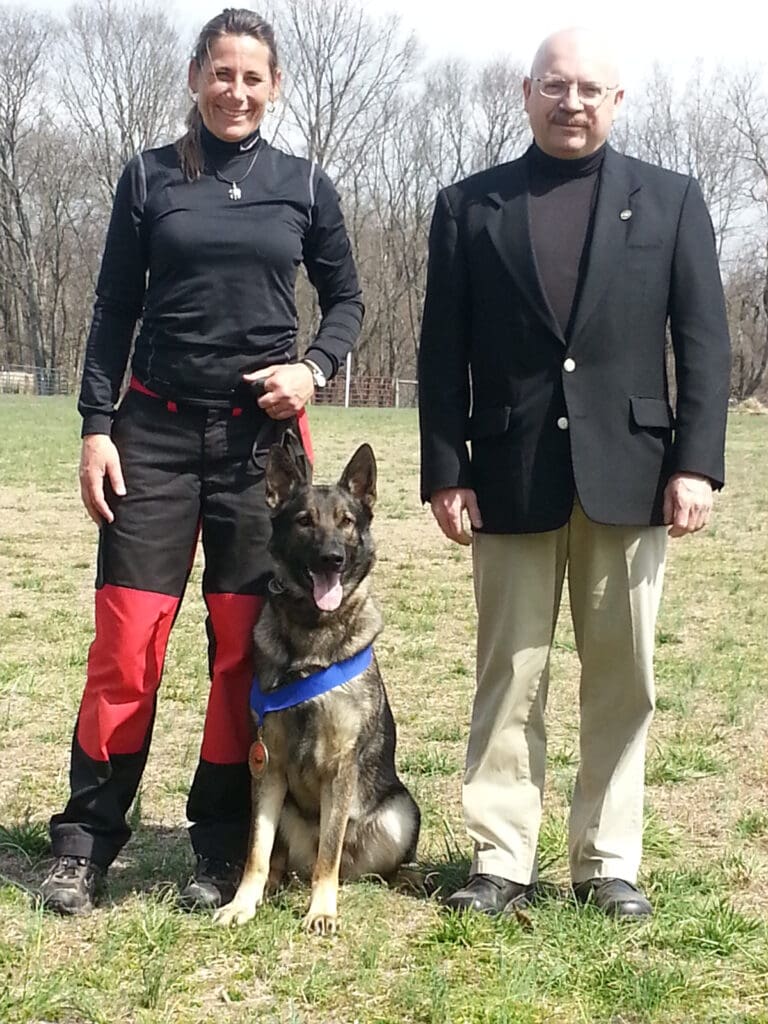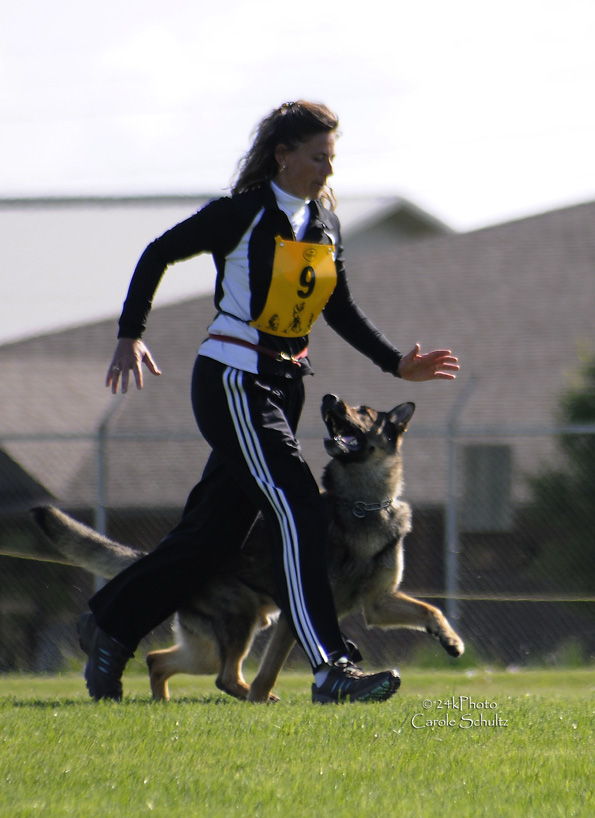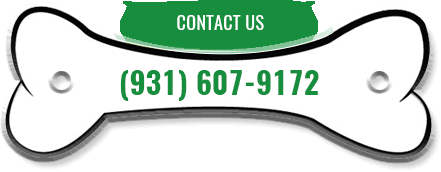What is Schutzhund?
Schutzhund is the German word for protection dog. It is a fundamental test that was designed to evaluate German Shepherds that are suitable for breeding. Schutzhund contains many elements that are designed to differentiate dogs in terms of trainability, handler responsiveness, courage, temperament and disposition. Schutzhund is not only a test but a dog sport. Many different breeds of dogs participate in the sport.
Happy Valley Kennel is actively involved in the sport of Schutzhund. We not only breed great German Shepherds, we train our German Shepherds as well. We feel that it is important to start the proper imprinting at an early age.
Krista Wade, whose training and Schutzhund experience has spanned over a decade and a half, has seen great success with all the German Shepherds she has trained and handled in Schutzhund. She has trained multiple SchH3 dogs to a National level of competition. She trained her current award winning German Shepherd, Berlin vom Glücklich Tal, starting at seven months of age and has taken him to an International level of competition. Berlin earned the High H.O.T. (Handler Owner Trained) award at the 2010 GSDCA-WDA National Championships, where they were named as members of the 2010 USA WUSV World Championship German Shepherd Team that competed in Sevilla, Spain.
There are many benefits to owning a German Shepherd whose parents and genealogy have participated in Schutzhund. Schutzhund tests and evaluates a German Shepherd’s temperament, disposition, and working ability. Any German Shepherd that participates in Schutzhund must meet or exceed these standards. Temperament, disposition, and working ability are extremely important characteristics to us at Happy Valley Kennel. To ensure that these desired characteristics are genetically passed on in our breeding program, we breed German Shepherds with proven Schutzhund bloodlines.


Begleithundprüfung
Temperament and disposition are extremely important breed characteristics to the German Shepherd breed. Therefore the Begleithundprüfung (BH), which means “traffic-sure companion dog test”, evaluates a dog’s temperament, disposition, obedience and control to the handler. The handler and dog team must successfully complete the BH to continue trialing for their Schutzhund titles.
There are three levels called “titles” that
increase in difficulty with each advancing level:
Schutzhund 1 (SchH1)
Schutzhund 2 (SchH2)
Schutzhund 3 (SchH3)
Each Schutzhund title has three phases or parts. The tracking phase (A), the obedience phase (B) and the protection phase (C). Each phase has a point value of 100 pts with the total possible points of 300 for all three phases. The BH and Schutzhund obedience and protection phases are performed on a field comparable to a soccer or football field. The tracking maybe conducted in a field consisting of some type of vegetation or dirt.
The BH consists of a pair of handler/dog teams. Each team must perform a specific pattern that includes various exercises. Each exercise is scored and assigned a rating by a certified judge who evaluates the handler and the dog:
» There are no treats or handler cues allowed.
» The dog is not allowed to wear any training aids.
» The dog, while performing on the field, must be attentive, responsive to commands and obedient to the handler.
» The team must execute the following exercises both on and off leash: Heeling, changes of pace from normal to fast, to slow, back to normal, right and left turns, about turns, stop and sit without a verbal command and heeling
through a group of four people while performing a figure 8 pattern.
» After completing these exercises the team must perform a sit and down out of motion, meaning the handler will continue to walk away from the dog after the command is given. The dog is to respond appropriately to the command given by the handler. After the down the handler will execute a recall where the dog must come directly to the handler when called, sit in front and wait to be commanded to finish by repositioning itself into the basic position.
While the first team is working on the field, the second team will perform a long down under distraction. The long down under distraction exercise requires the handler to heel the dog to a specified area on the side of the field, down the dog on command, leaving the dog in the down position while the first dog performs its routine. The dog is not allowed to leave this area of the field. Once the first dog has finished their routine the second handler will approach the dog in the down, command the dog to sit, put their leash on the dog and heel to the base point to perform their routine. After both team pairs have completed the long down and routine they will heel to the judge to report out. The judge will give their critique of the teams.
Teams that successfully complete the obedience portion of the BH will continue with the traffic portion of the BH test. In this portion of the test the dog is evaluated for temperament and disposition. The dog must walk through a group of people, sit or lie down in a group of people, walk on a loose leash as a jogger, bicycle and car pass by, in addition to, remaining calm while begin tied out with the handler out of view and another dog walking by. Any dog that demonstrates a lack of temperament, aggression or fear may be dismissed by the judge. Upon successfully completing the BH, the dog may continue competing for the next title, the SchH1.
Schutzhund 1, 2 & 3
Phase A: Tracking
A track is laid in a field by a person (track layer) walking through the field in a designated pattern. While laying the track the track layer will place objects called articles on the track that the dog must indicate or recognize while tracking. A track has a flag to indicate the start of the track and the last article indicates the end of the track. The dog is judged on its ability to discriminate between the odor on and around the track, their intensity and correctness. The dog is to follow each footstep of the track. The handler after giving the dog the command to search must remain at the end of the leash which is 3 meters long. The maximum number of possible points awarded is 100. The minimum score for a team to pass the tracking phase is 70 points.
SchH1 Track
SchH2 Track
SchH3 Track
Phase B: Obedience
All exercises are performed off leash on a field comparable to a soccer/football field. Working in pairs like in the BH test one team will perform the long down under distraction while the first team will perform their routine switching after the first teams routine is complete.
As in the BH test, the dogs in SchH1, SchH2 & SchH3 must execute the following exercises while being attentive, responsive to commands and obedient to the handler: heeling, heeling while a gun is fired, right and left turns, about turns, changes of pace from normal, to slow, to fast, then back to normal again, stopping and sitting without a verbal command, a figure 8 in a group of four people, and a sit out of motion.

SchH1
SchH2
SchH3
All three levels SchH1, SchH2 and SchH3 must perform a send out. This exercise commands the dog to leave the handler running down the field away from the handler. At the command of the handler the dog must down and remain in the down position until the handler walks to their dog. Once the handler is in the basic position the handler will command the dog to sit. The dog should be at all times under control, attentive to the handler and heel freely with the handler. The obedience phase consists of 100 points with each exercise being assigned a numerical value and rating. The minimum score for a team to pass the obedience phase is 70 points

Phase C: Protection
The protection routine is designed to test the dog’s natural defensive drives, as well as, their obedience. This phase requires extreme control and obedience from the dog. The protection phase is performed on a field comparable to a soccer/football field. The handler is expected to have control of the dog at all times. If the dog loses control and or the handler is unable to control the dog the judge will dismiss the team from the competition and they will be disqualified.
Blinds, which are triangular shaped object, are positioned on the field in an alternating pattern across from each other. The dog must search each blind upon the command of the handler. The dog must check the blind searching for the suspect also called the decoy or helper. SchH 1, SchH 2 & SchH3 dogs must find the decoy in the designated blind. The dog should perform a hold and bark indicating that he has found the decoy. The dog will hold the decoy in the blind until the handler arrives. Upon the judges request the handler will call the dog out of the blind to the basic position beside the handler. The handler will order the decoy out of the blind. The handler will heel the dog under control to a designated area where the handler will down the dog. The next exercise is called the escape exercise it is performed in the same manner at all three levels. The dog will apprehend the decoy as the decoy flees. The dog will engage the decoy on the padded sleeve that the decoy wears on either arm. The dog must release on command. The decoy will re-attack the dog and the dog will reengage the decoy. The helper will pick the dog up and drive the dog. After the decoy sets the dog down and stops moving the handler will command the dog to release the decoy.
SchH1
SchH2
SchH3
The courage test is designed to test the dog’s ability to withstand a threat that is rushing toward them. The dog should not try to run away, shy or back down. The dog should engage the decoy showing power and strength. After the dog initially engages the decoy the handler will command the dog to release, after the dog releases the decoy will re-attack the dog. The dog should engage a second time. Once the decoy stops the drive the dog will release upon the handlers command. The handler will approach the dog, sit the dog, and then heel the dog to the side transport position, transporting the suspect to the judge. After the dog and handler have successfully transported the suspect to the judge the handler may put a leash on the dog for the judge’s critique. At no time can the dog be out of control. If a dog fails to release on the third release command the team is disqualified. A judge may dismiss any dog that he deems out of control. To pass the protection phase a dog must earn a minimum of 80 points out of 100 possible points. Protection is an example of ultimate control and obedience.
Training a German Shepherd or any breed of dog to compete in Schutzhund involves time, patience, a desire to work with your dog, persistence and knowledgeable trainers and helpers. Because Schutzhund is a multi faceted sport a great deal of time and dedication is required to train a dog properly. Despite all the hard work it is truly rewarding and self-fulfilling to realize the fruits of all your labor by successfully obtaining a title, while recognizing the high level of communication you have achieved with your dog.


